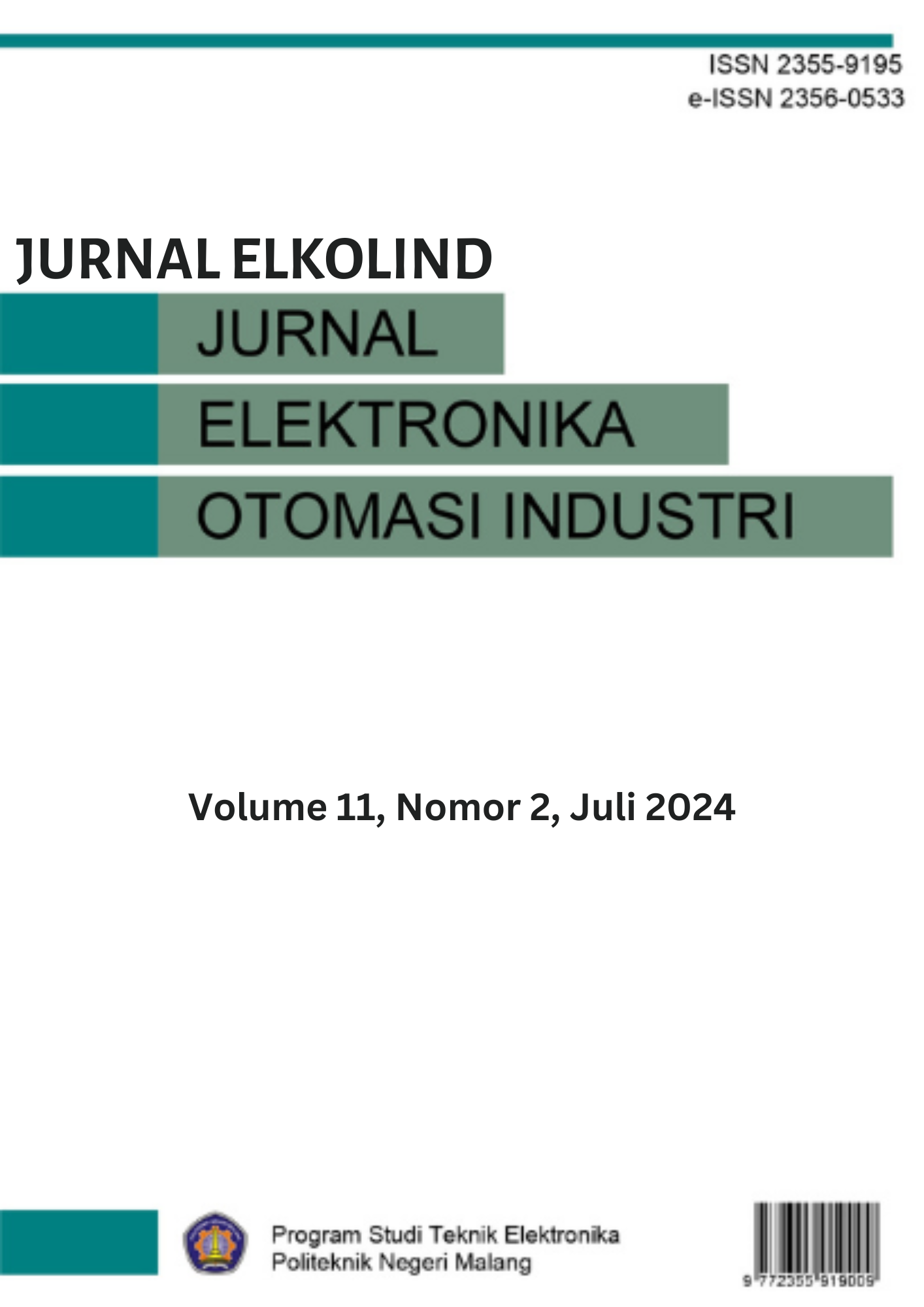Main Article Content
Abstract
Robotics has undergone a significant transformation and has become one of the most amazing fields of technology in the 21st century, such as wheeled robots. One mechanism that can make wheeled robots move quickly is a swerve drive. Swerve drive is an omnidirectional drivetrain in which all wheels are steered and driven independently. In order to get maximum results when using the swerve drive mechanism, kinematic modeling is needed so that all wheels can be integrated and create fast robot movements that can maneuver well. Kinematic modeling on robots functions to simplify the input given to the robot and maximize the output from each motor. The method that can be used to obtain kinematic modeling of the four-wheel swerve drive mechanism is by taking a geometric and trigonometric approach. The geometric and trigonometric approaches are very suitable to be applied to modeling the kinematics of robots, which have basic spatial and triangular relationships based on the description of vectors between their forces. The results of the tests that have been carried out show that kinematics can make the robot move effectively by simplifying the input given, but still with maximum output. The kinematics for the four-wheel swerve drive have a good system response with a geometric and trigonometric approach.
Keywords
Article Details
Copyright (c) 2024 Ade Fitra Rohmansyah, Noorman Rinanto, Ryan Yudha Adhitya, Ii Munadhif, Isa Rachman, Muhammad Khoirul Hasin, Agus Khumaidi, Zindhu Maulana Ahmad Putra

This work is licensed under a Creative Commons Attribution 4.0 International License.
References
- M. Nurul Achmadiah, A. anwar Rosyidin, A. Pracoyo, I. Siradjuddin, D. A. Permatasari, and G. Al Azhar, “Desain permodelan dan simulasi Field Oriented Control (FOC) menggunakan motor BLDC,” Jurnal Elektronika dan Otomasi Industri, vol. 10, no. 3, pp. 361–368, Sep. 2023, doi: 10.33795/elkolind.v10i3.4416.
- Hu Jiawen, “The Chassis Design of the Swerveomni Directional Wheel,” Academic Journal of Engineering and Technology Science, vol. 4, no. 5, 2021, doi: 10.25236/ajets.2021.040505.
- V. Hendrawan, “IMPLEMENTASI INVERS KINEMATICS PADA SISTEM PERGERAKAN MOBILE ROBOT RODA MEKANUM,” Malang, 2014.
- N. Nada Mufti, O. Haki Pranata, and M. M. Rijal Wahid, “STUDI LITERATUR: TANGRAM SEBAGAI MEDIA PEMBELAJARAN GEOMETRI,” 2020.
- Y. Gusmania and N. Agustyaningrum, “Analisis Pemahaman Konsep Matematis Mahasiswa pada Mata Kuliah Trigonometri,” Jurnal Gantang, vol. 5, no. 2, pp. 123–132, Sep. 2020, doi: 10.31629/jg.v5i2.2493.
- S. Syuhendri, L. Sania, and H. Akhsan, “PENGEMBANGAN BAHAN AJAR TEKS PERUBAHAN KONSEPTUAL MATERI FISIKA DASAR TOPIK KINEMATIKA,” Jurnal Kumparan Fisika, vol. 4, no. 1, pp. 43–50, May 2021, doi: 10.33369/jkf.4.1.43-50.
- A. P. Abseno, “PENERAPAN KINEMATIKA UNTUK LOKALISASI PADA ROBOT SEPAK BOLA BERODA,” 2019.
References
M. Nurul Achmadiah, A. anwar Rosyidin, A. Pracoyo, I. Siradjuddin, D. A. Permatasari, and G. Al Azhar, “Desain permodelan dan simulasi Field Oriented Control (FOC) menggunakan motor BLDC,” Jurnal Elektronika dan Otomasi Industri, vol. 10, no. 3, pp. 361–368, Sep. 2023, doi: 10.33795/elkolind.v10i3.4416.
Hu Jiawen, “The Chassis Design of the Swerveomni Directional Wheel,” Academic Journal of Engineering and Technology Science, vol. 4, no. 5, 2021, doi: 10.25236/ajets.2021.040505.
V. Hendrawan, “IMPLEMENTASI INVERS KINEMATICS PADA SISTEM PERGERAKAN MOBILE ROBOT RODA MEKANUM,” Malang, 2014.
N. Nada Mufti, O. Haki Pranata, and M. M. Rijal Wahid, “STUDI LITERATUR: TANGRAM SEBAGAI MEDIA PEMBELAJARAN GEOMETRI,” 2020.
Y. Gusmania and N. Agustyaningrum, “Analisis Pemahaman Konsep Matematis Mahasiswa pada Mata Kuliah Trigonometri,” Jurnal Gantang, vol. 5, no. 2, pp. 123–132, Sep. 2020, doi: 10.31629/jg.v5i2.2493.
S. Syuhendri, L. Sania, and H. Akhsan, “PENGEMBANGAN BAHAN AJAR TEKS PERUBAHAN KONSEPTUAL MATERI FISIKA DASAR TOPIK KINEMATIKA,” Jurnal Kumparan Fisika, vol. 4, no. 1, pp. 43–50, May 2021, doi: 10.33369/jkf.4.1.43-50.
A. P. Abseno, “PENERAPAN KINEMATIKA UNTUK LOKALISASI PADA ROBOT SEPAK BOLA BERODA,” 2019.
